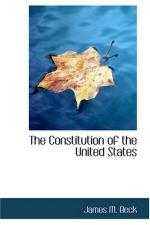On July 16 the compromise was finally adopted of recognizing the claims of the larger States to proportionate representation in the House of Representatives, and recognizing the claims of the smaller States by according to them equal representation in the Senate. This great result was not effected without the first break in the convention, for the delegates from New York left in disgust and never returned, with the exception of Hamilton, who occasionally attended subsequent sessions. Such was the great concession that was made to secure the Constitution; and the only respect in which the Constitution to-day cannot be amended is that by express provision the equality of representation in the Senate shall never be disturbed. Thus it is that to-day some States, which have less population than some of the wards in the city of New York, have as many votes in the Senate as the great State of New York. It is unquestionably a palpable negation of majority rule, for as no measure can become a law without the concurrence of the Senate—now numbering ninety-six Senators—a combination of the little States, whoso aggregate population is not a fifth of the American people, can defeat the will of the remaining four-fifths. Pennsylvania and New York, with nearly one-sixth of the entire population of the United States, have only four votes in ninety-six votes in the Senate.
Fortunately, political alignments have rarely been between the greater and the smaller States exclusively. Their equality in the Senate was a big price to pay for the Union, but, as the event has shown, not too great.
The convention next turned its attention to the Executive and the manner of its selection, and upon this point there was the widest contrariety of view, but, fortunately, without the acute feeling that the relative power of the States had occasioned.
Then the judiciary article was taken up, and there was much earnest discussion as to whether the new Constitution should embody the French idea of giving to the judiciary, in conjunction with the Executive, a revisory power over legislation. Three times the convention voted upon this dangerous proposition, and on one occasion it was only defeated by a single vote. Fortunately, the good sense of the convention rejected a proposition, that had caused in France constant conflicts between the Executive and the Judiciary, by substituting the right of the President to veto congressional legislation, with the right of Congress, by a two-thirds vote of each House, to override the veto, and secondly by an implied power in the Judiciary to annul Congressional or State legislation, not on the grounds of policy, but on the sole ground of inconsistency with the paramount law of the Constitution. In this adjustment, the influence of Montesquieu was evident.
These and many practical details had resulted in an expansion of the fifteen proposals of the Virginia plan to twenty-three.




